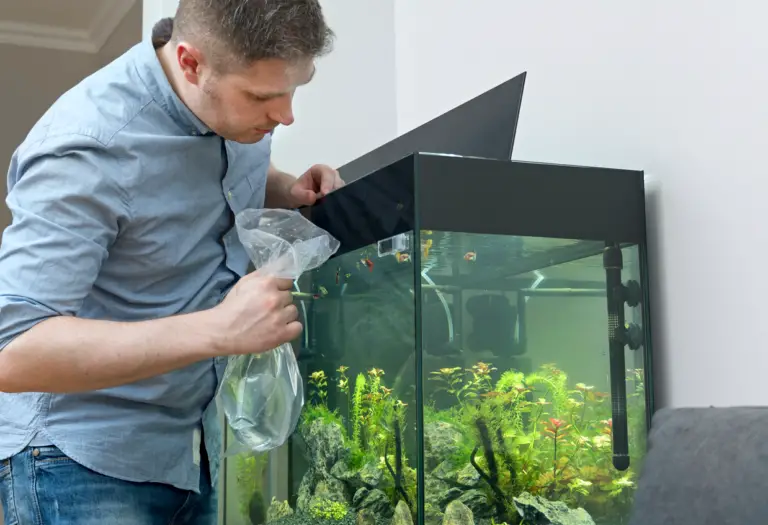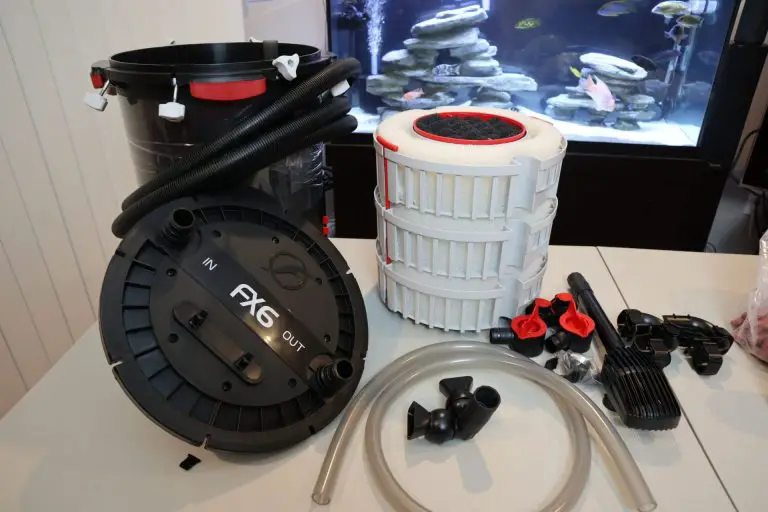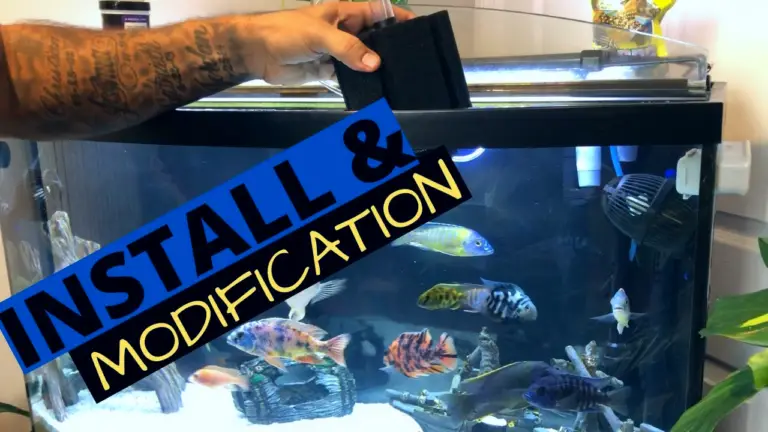Bacterial Bloom And High Ammonia – Don’t Panic (Easy Fix!)
First of all, what I need you to do is settle down! Don’t panic. A bacterial bloom and high ammonia is easy to take care of and after this article, you’re going to feel much better, I promise….ok, are we calm? Then Let’s go!
A Bacterial Bloom is when your fish tank’s clarity changes to a milky white cloudy fog. It’s caused by a rapid increase in Heterotrophic Bacteria, which can be seen by the naked eye. These bacteria feed on organic matter like the dissolved solids in your water, dead or decaying fish or plants, excess fish waste, and/or unneatened food left in the tank. Anything organic.
Bacterial Bloom In Aquarium
A bacterial bloom can happen both in a new tank setup and in an established tank. For both, the solution will be the same, which is don’t panic!
In a new tank setup, while your tank is cycling without fish you don’t need to do anything. Literally. The bloom will dissipate on its own with time as your tank completes the cycle.
In an established tank it’s a similar solution except that since we have fish in the tank now you have to worry about the ammonia spike a bacterial bloom can cause. The only difference in this case is to add Seachem Prime during the bacterial bloom to detoxify the ammonia keeping the water safe while the bacterial bloom dissipates.
What Is Bacterial Bloom
First, we need to discuss 2 types of bacteria that live in our tanks. Heterotrophic and Autotrophic. I know, those are big words but I’m going to make this very simple, ya know me!
Their biggest differences are heterotrophic bacteria feed on organic matter, like poop, uneaten food, dead fish, dead plants, and anything organic in your water. We’re going to call these the “cloud-causing bacteria”. Because that’s what they are. These bacteria are the ones floating in your water column making your water milky white and cloudy.

Autotrophic bacteria feed on inorganic matter like ammonia, nitrite, and nitrate, I’m sure you guys are more familiar with this type. We’ll call these “beneficial bacteria”, easy right?
Probably 90% of bacterial blooms happen during a new tank setup, and this is perfectly normal. This bacterial bloom, also known as bacterial blossom, happens because of the nutrient-rich, new tap water you’ve just added to your tank.
The organic matter in that water causes the Cloud Causing Bacteria to grow and rapidly reproduce, and when I say rapid I mean in minutes. They can double in 15-20 minutes.
These are the types of bacteria we don’t want in excess in our tanks, why? Because these bacteria actually do live in the water column and they reproduce so rapidly, once there are so many they can be seen by the naked eye in your water, they are that milky white fog in your tank, the bacterial bloom!
Not only do they feed on the organics in your fresh new dechlorinated water but if you have fish in the tank already while its cycling they also feed on the organic waste from the fish, meaning their poop!
How To Fix Bacterial Bloom
The good news is the solution to getting rid of these Cloud Causing Bacteria during a new tank bacterial bloom is simple. Do nothing! That’s right, no water changes, no additives, no chemicals needed.
Water changes are actually going to make the Cloud Causing Bacteria left over in your tank to reproduce even faster when you add in new nutrient-rich water again and the bacterial bloom will just return. You’ll just be resetting the bloom every time.
With time as your tank cycles, your beneficial bacteria, which is the nitrifying bacteria we do want in excess, will eventually grow and starve the cloudy water-causing bacteria away. Problem solved!
Bacterial Bloom In An Established Aquarium
Now, if you’re experiencing a bacterial bloom and your tank is already established, meaning you’ve had it up and running with fish for a few months already, you know for sure your tank has been cycled, and all of a sudden you get a bacterial bloom, this one’s a bit more tricky.
This means that something is out of wack with the ecosystem in your tank. Some organic compound, in excess, has found its way into your tank and now the Heterotrophic (Cloud Causing) bacteria are back and reproducing rapidly again.
This could be caused by overfeeding. Maybe you came home late and tired one night and the guys got much more to eat than usual. Well, if a bunch of uneaten food got trapped under a rock or behind a piece of décor this extra organic matter can cause a bacterial bloom.
Maybe you added too many fish at once causing more fish poop to accumulate in your tank. Or even worse, you could have a dead fish somewhere and not even know it. These organic decomposing materials can cause a bacterial bloom and high ammonia in an established aquarium.
The issue for concern this time though is that we probably have a bunch of fish in our tank. When a bacterial bloom occurs you can get a spike in ammonia from all the organics the heterotrophic bacteria are feeding on.
Ammonia is deadly to our fish, even in very small amounts. Our nitrifying bacteria are going to need time to catch up to this spike in ammonia in order to properly convert it to less toxic nitrate.
These free-floating cloud-causing bacteria are also going to heavily deplete the oxygen levels in the tank as well as they become aerobic during a bloom.
These guys can switch from aerobic and anaerobic, unlike the good guys we like in tanks, the autotrophic beneficial bacteria. The problem is our good guys, the Beneficial Bacteria, need way more time to reproduce and catch up to this increase in ammonia.

In this situation, I recommend dosing your entire tank volume with Seachem Prime to detoxify that ammonia spike keeping your water safe for the fish and giving your beneficial bacteria more time to take care of it.
Also, the cloud-causing bacteria is also going to fight for all the oxygen in your tank, the cloudier it gets the more oxygen it’s going to use up. Since you have fish in the tank I also recommend making sure you have adequate surface agitation for oxygen transfer. If you already did, you may want to add more during the bloom. An extra air stone or wave maker never hurt any…fish!
How Long For Bacterial Bloom To Clear
At this point, you need to find the underlying cause of the bacterial bloom. If it’s excess food or waste in your tank, time to vacuum that extra detritus out of your tank.
If it’s a dead fish or dead plants you’ve got to scoop that stuff up and get it out as well.
Once you’ve removed whatever extra organic material caused the bloom, then all you need to do is wait. The heterotrophic or cloud-causing bacteria will soon starve and die off and you’ll be back to having crystal-clear aquarium water in no time.
Keep in mind that if you do have fish in the tank during the bacterial bloom adding Seachem Prime and more surface agitation for oxygen transfer will be beneficial.
Other Causes For Cloudy Aquarium Water
There are plenty of reasons why your water can remain cloudy even after your bacterial bloom period has passed. Many beginners make common mistakes like overfeeding or over lighting which are just the tip of the iceberg when it comes to cloudy water problems.
 Luckily, I’ve put together all the causes and their solutions in one place! My book on getting and keeping crystal clear water will determine the problems you’re causing and show you how to fix them for good. Money back guaranteed!
Luckily, I’ve put together all the causes and their solutions in one place! My book on getting and keeping crystal clear water will determine the problems you’re causing and show you how to fix them for good. Money back guaranteed!
Get your copy in eBook or Paperback here – Crystal Clear Aquarium Water
The Beginners Aquarium-Keeping APP You’ve Been Waiting For – Aquabuildr
Aquabuildr is a comprehensive mobile application designed to assist aquarium enthusiasts, from beginners to experts, in setting up and managing their aquariums effectively. The app offers a range of features to ensure the health and vitality of your aquatic environment:
- Fish Compatibility Algorithm: Aquabuildr’s patent-pending AI technology analyzes your tank’s parameters to suggest fish species that are 100% compatible, promoting a harmonious aquatic community.
- Dosing Diary & Water Parameter Logging: Maintain detailed records of your tank’s health, including dosing schedules and water parameters, to ensure optimal conditions for your aquatic life.
- To-Do Tasks & Reminders: Organize and set reminders for essential tank maintenance tasks, helping you keep your aquarium in top condition.
- Ultimate History Tool: Access a comprehensive log of your aquarium’s history, allowing you to monitor changes and make informed decisions about its care.
- AI Chat Support: Receive instant answers and advice on fish care, water quality, and more, making your aquarium journey stress-free.
Aquabuildr is available for download on both iOS and Android devices:
- iOS: Download on the App Store
- Android: Get it on Google Play
For more detailed information, visit the official Aquabuildr website.
To see Aquabuildr in action, check out the introductory video below:







